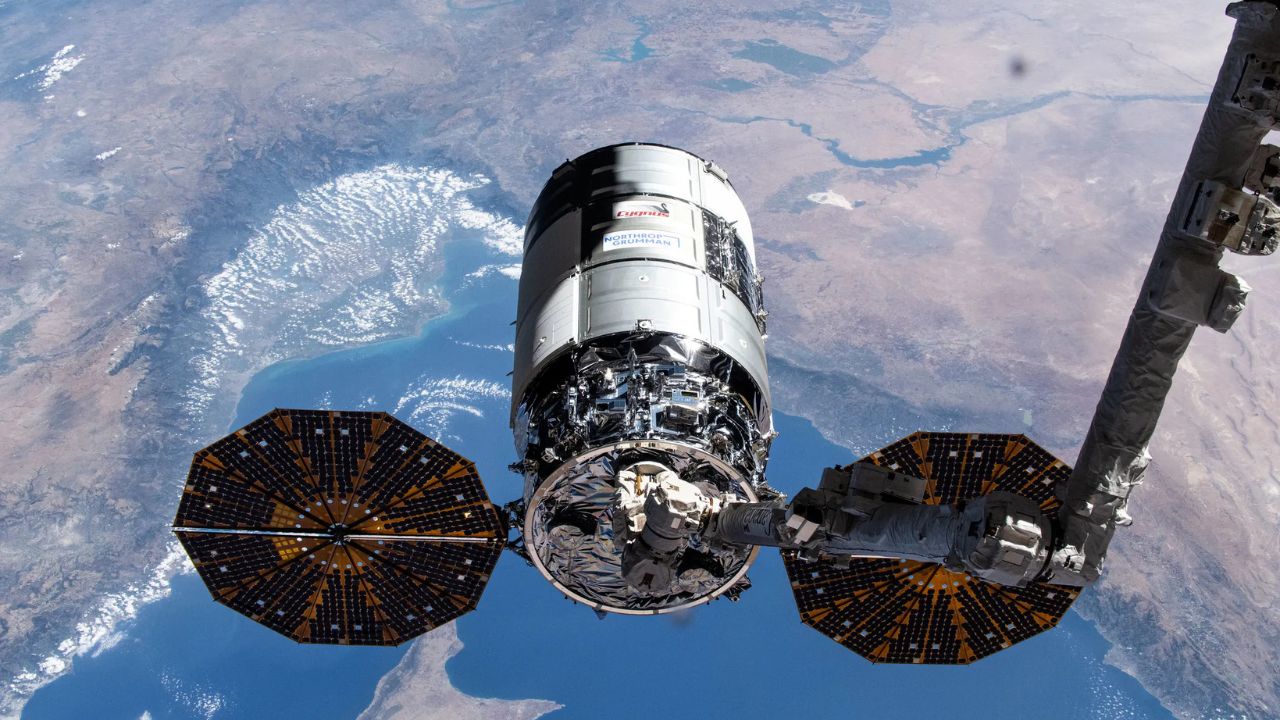Media Webinar Showcases Research Launching on Upcoming Mission to the ISS

Northrop Grumman’s Cygnus spacecraft approaches the International Space Station
Media are encouraged to join a webinar hosted by the ISS National Lab and NASA on Sept. 10 featuring science launching on Northrop Grumman CRS-23
September 5, 2025
KENNEDY SPACE CENTER (FL), September 5, 2025 – The next Northrop Grumman commercial resupply services (CRS) mission to the International Space Station (ISSInternational Space Station), launched by SpaceX, will carry a diverse array of research, including several investigations sponsored by the ISS National Laboratory®. A pre-launch science webinar for media will be held on Wednesday, September 10 at 1 p.m. EDT to highlight projects on this mission.
Projects launching on this mission include research to advance:
- Germicidal biotechnologies
- In-space manufacturing capabilities for more effective therapeutics
- New technology to remove space debris
Media who would like to participate in this webinar must register for Zoom access no later than one hour in advance. The webinar will be recorded and uploaded to the ISS National Lab YouTube channel upon completion. The public is encouraged to submit questions for the research teams prior to the webinar through the ISS National Lab (@ISS_CASIS) or NASA’s International Space Station (@Space_Station) social handles.
During the webinar, Phillip Irace, science program director for the ISS National Lab, and Liz Warren, associate chief scientist for NASA’s ISS Program, will provide general insights into the mission and answer questions from registered media. The following panelists will then join the webinar to discuss their projects on this mission.
- Paul Westerhoff, Arizona State University: This project, funded by the U.S. National Science Foundation and in collaboration with BioServe Space Technologies, examines how germicidal ultraviolet light affects the formation of biofilms in space-based water systems. Findings could lead to new ways to protect life support systems and crew members during spaceflight and reduce biofilm-related challenges on Earth.
- Robert Garmise, Bristol Myers Squibb: Building on prior investigations launched to the space station, this project will use Redwire Space’s PIL-BOX facility to crystallize small organic molecules in space to improve the Earth-based production of medications.
- Joel Sercel, TransAstra Corporation and Mike Lewis, Voyager Technologies: This project will test a new system to capture and control space debris leveraging Voyager’s Bishop Airlock. The system could help clear orbital paths and provide a cost-effective option for the end-of-life disposal of satellites.
- Mohammad Kassemi, Case Western University: This NASA-sponsored project will study how gases that do not condense into liquids could improve the storage of fuel within tanks in space. This will be important for future deep space missions that require long-term storage of fuels and the transfer of fuels in reduced gravity.
NASA’s Northrop Grumman CRS-23 mission is slated to launch no earlier than Sunday, September 14, 2025, from Launch Complex 40 at Cape Canaveral Space Force Station in Florida. Additional information about investigations launching on this mission will be made available in the coming days on our launch page.
Join us to hear more about the exciting investigations heading to the space station to advance science and benefit humanity. To learn more about ISS National Lab-sponsored science and how it benefits life on Earth, visit our website.
Download a high-resolution image for this release: Northrop Grumman CRS-23
Media Contact:
Patrick O’Neill
904-806-0035
PONeill@ISSNationalLab.org
# # #
About the International Space Station (ISS) National Laboratory: The International Space Station (ISS) is a one-of-a-kind laboratory that enables research and technology development not possible on Earth. As a public service enterprise, the ISS National Laboratory® allows researchers to leverage this multiuser facility to improve quality of life on Earth, mature space-based business models, advance science literacy in the future workforce, and expand a sustainable and scalable market in low Earth orbit(Abbreviation: LEO) The orbit around the Earth that extends up to an altitude of 2,000 km (1,200 miles) from Earth’s surface. The International Space Station’s orbit is in LEO, at an altitude of approximately 250 miles.. Through this orbiting national laboratory, research resources on the ISS are available to support non-NASA science, technology, and education initiatives from U.S. government agencies, academic institutions, and the private sector. The Center for the Advancement of Science in Space® (CASIS®) manages the ISS National Lab, under Cooperative AgreementA cooperative agreement is Federal assistance that establishes a relationship between the U.S. Government and a recipient in which the principal purpose of the relationship is to accomplish a public purpose of support or stimulation. Since 2011, the Center for the Advancement of Science in Space™ (CASIS™) has managed the National Laboratory® through a Cooperative Agreement with NASA. with NASANational Aeronautics and Space Administration, facilitating access to its permanent microgravityThe condition of perceived weightlessness created when an object is in free fall, for example when an object is in orbital motion. Microgravity alters many observable phenomena within the physical and life sciences, allowing scientists to study things in ways not possible on Earth. The International Space Station provides access to a persistent microgravity environment. research environment, a powerful vantage point in low Earth orbit, and the extreme and varied conditions of space. To learn more about the ISS National Lab, visit our website.
As a 501(c)(3) nonprofit organization, CASIS(Abbreviation: CASIS™) The nonprofit organization that manages the ISS National Lab, which receives at least 50 percent of the U.S. research allocation on the International Space Station to facilitate research that benefits humanity (NASA manages the other 50% and focuses on research for space exploration purposes). accepts corporate and individual donations to help advance science in space for the benefit of humanity. For more information, visit our donations page.